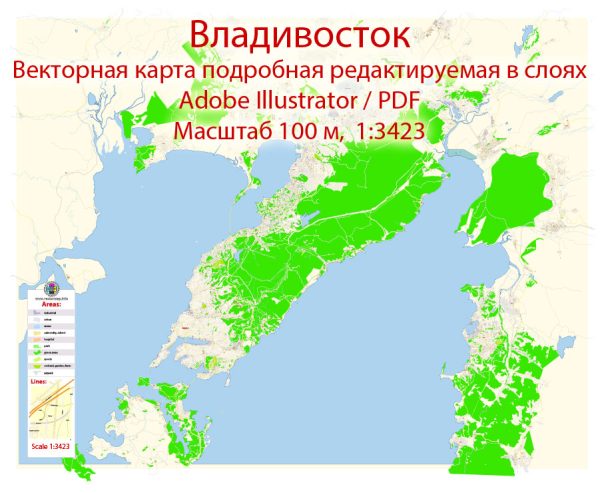Vladivostok is a major port city and the administrative center of Primorsky Krai, located in the Russian Far East. It is situated on the Pacific Ocean, near the borders of China and North Korea. Vladivostok is one of Russia’s most important cities in terms of its strategic location, economic significance, and role in international trade. Here’s a description of the urban development in Vladivostok:
- Geography and Location: Vladivostok is characterized by its stunning geography, with hills and mountains that offer panoramic views of the surrounding area. The city is situated on the shores of the Golden Horn Bay and Amur Bay, providing it with a natural deep-water harbor, which has played a crucial role in its development as a major port city.
- Historical Development: Vladivostok has a rich history, dating back to the late 19th century. It served as a military outpost and later as an important trading post. The city’s development was closely linked to Russia’s expansion into the Far East and its role as a key transportation and logistical hub.
- Architecture: The city’s architecture is a mix of historical and modern styles. You can find well-preserved 19th and early 20th-century buildings, which include European-style structures from the Russian Empire. In addition, there are more recent Soviet-era buildings and modern skyscrapers that have been constructed as the city has grown.
- Infrastructure: Vladivostok has a well-developed infrastructure, including a network of roads, bridges, and tunnels that connect the various parts of the city and the surrounding region. The Russky Bridge, one of the longest cable-stayed bridges in the world, connects Russky Island to the mainland.
- Transportation: The city has an extensive transportation network, including buses, trams, and a modern funicular railway. Vladivostok International Airport serves as a major gateway to the Russian Far East, connecting the city to both domestic and international destinations.
- Economic Significance: Vladivostok is a crucial economic center for the Russian Far East. It hosts various industries, including shipping, manufacturing, and fishing. The port plays a central role in facilitating international trade with Asia-Pacific countries.
- Education and Culture: Vladivostok is home to several universities and cultural institutions, including the Far Eastern Federal University. The city hosts numerous cultural events and festivals, reflecting its diverse and multicultural population.
- Tourism: Vladivostok has been developing its tourism sector in recent years. Visitors come to explore the city’s historical sites, enjoy the beautiful natural surroundings, and experience the local cuisine. The city has several parks, museums, and recreational areas.
- Urban Planning: The city has undergone urban development and renovation efforts to improve its infrastructure and public spaces. These developments include modernized roads, improved public transportation, and efforts to beautify the city’s appearance.
- Future Prospects: Vladivostok is expected to continue growing as a key city in the Russian Far East, especially as Russia seeks to enhance its economic and political engagement with the Asia-Pacific region. This growth may involve further urban development and infrastructure improvements.
In recent years, Vladivostok has become known not only for its strategic importance but also as a vibrant and cosmopolitan city that serves as a bridge between Russia and the Asia-Pacific region. The city’s urban development reflects this dual role, with a blend of historical charm and modern progress.


 Author: Kirill Shrayber, Ph.D.
Author: Kirill Shrayber, Ph.D.